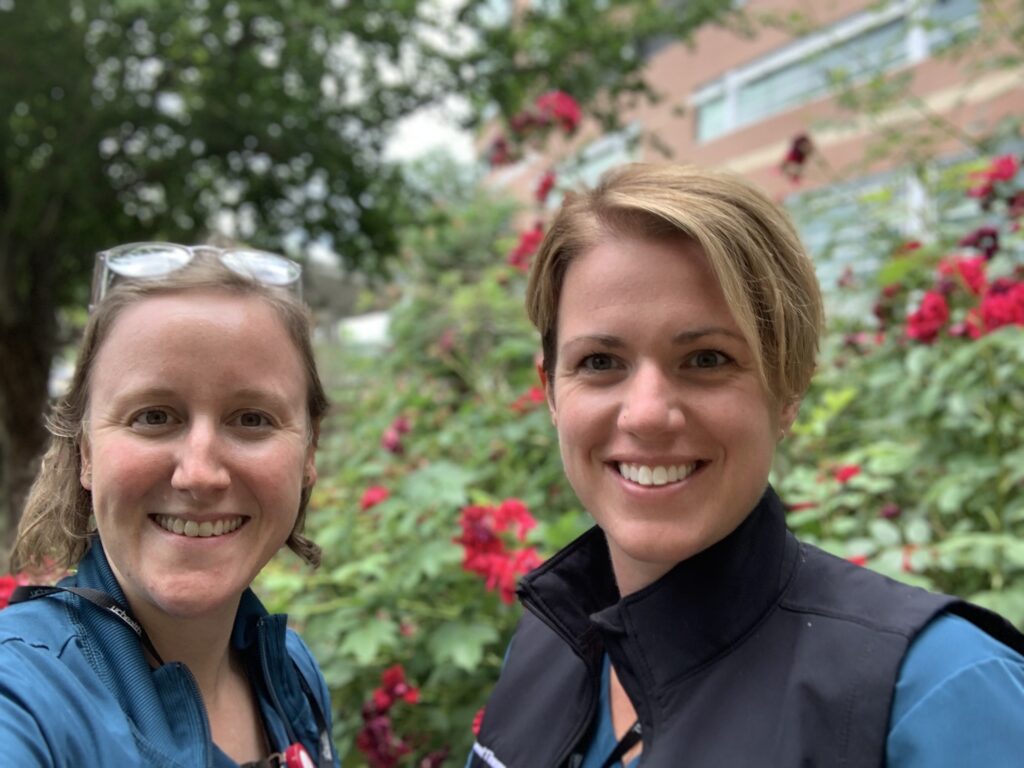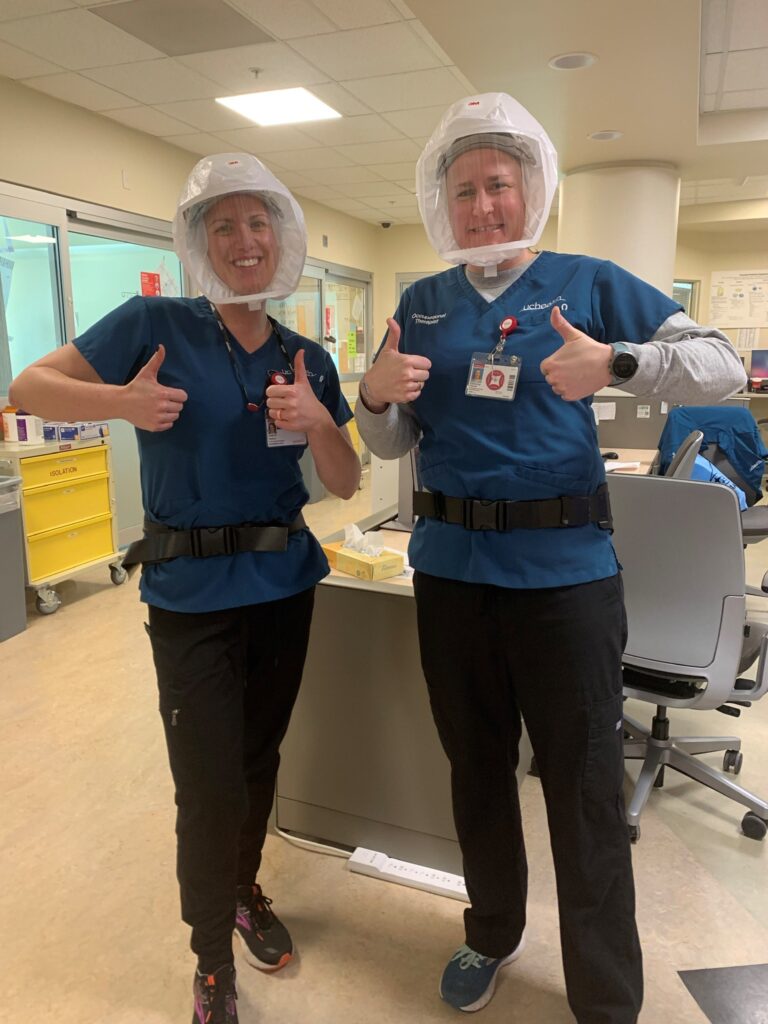Meet Dr. Wallner, a physical therapist and clinical innovator in acute care physical therapist practice.

Jess Wallner, PT, DPT graduated from the University of Colorado in 2011 with her doctorate in physical therapy. She has primarily practiced in the inpatient hospital setting with a passion for trauma, ICU level care, women’s health, and of course the Emergency Department. Jess has been fortunate to be a part of several pilot projects over the course of her 10+ year career in Denver, CO. Some include establishing PT in the ED, evolving inpatient antepartum physical therapy, dry needling implementation in the hospital, and co-piloting of a multidisciplinary team approach to patients with complex discharge planning needs. Jess now practices at VCU- Medical Center of Virginia in Richmond, VA where she lives with her husband and their two human-like dogs.
Describe how you became involved in Emergency Department Physical Therapist Practice.
During one of my clinicals in PT school at a Denver hospital, I was introduced to the role of physical therapists in the ED. We mainly provided services to the Clinical Decision Unit (CDU). Occasionally we provided services to the main ED typically for gait training or equipment recommendations. I started to see not only the value in this practice but also the potential. The more patients I evaluated and treated in the main ED, the more my curiosity grew for how many consults we were missing!
When I started at University of Colorado Hospital (UCH), one of my main points of interest was the current workflow of the ED. I began by changing my hours later in the day to capture more patients, tracking consults, and becoming a more consistent face to the ED staff. Forming relationships with providers in the ED is crucial – and consistency goes a long way. Soon after, I was part of a core group that initiated the pilot program of staffing PTs in the ED full time during the week.
I was committed to raising awareness of the diverse skill set we could offer, advocating for consults, and really starting to ‘show off’ all we could provide. It worked!
Describe your practice setting and ED PT model.
I am now practicing in Richmond, Virginia at another large level one trauma hospital. We had to re-shift our model due to staffing changes, etc (always moving pieces!) but intend to regain momentum by staffing the ED with a PT during the week.

Why do you think this is a valuable practice area?
Oh goodness, this question has few boundaries! When I consider the variety of patient populations and settings that PTs treat, it only makes sense for a PT to be part of the ED Team. The foundations of differential diagnosis we hold as Doctors of Physical Therapy is clearly put to (hard) work in the ED. As primarily an inpatient acute care PT, what I also enjoy about the ED is that I ‘keep up’ my what we sometimes refer to as “outpatient ortho” skill set, particularly manual therapy. Physical therapists are able to offer additional examination and evaluation skills perhaps not held by other ED providers. Additionally, we are often able to allocate time to treatment interventions including the ever-powerful patient education.
What was the biggest adjustment for you in practicing in the ED?
The “mind shift.” My most exhausting, yet rewarding, days at work were as we called “my ED day.” The variety of patients with PT consults in the ED tested my neuro-plasticity by tenfold. I embraced it.
In the inpatient setting it often filters down to my role as a PT to mobilize and assist with discharge planning. With each new consult in the ED, I started from a much higher view point to then refine the goal I was there to achieve. For example, was my role to assess mobility and assist with discharge to the next level of care in the safest way possible? Did I receive the consult to provide recommendations for allowing the patient to get home with appropriate DME? Or was the attending looking for assistance with differential diagnosis of musculoskeletal pain or vertigo? The list is amazing!
Do you have an area of specialty?
I do not hold a specific specialty in terms of certification, however, there are of course many areas of primary interest. Perhaps contrary to others, my gut didn’t sink when a patient presented to the ED with back pain. The lumbo-pelvic and hip complexity always sparked my interest. Along this spectrum, I hold a passion for women’s health, especially pelvic pain and the antepartum/postpartum woman.
What barriers did you have to overcome personally and within your facility to practice successfully in this environment?
Colleagues likely wouldn’t describe me as “shy” but that’s exactly how I felt within the first year or so of practicing in the ED. It comes down to confidence. In order to be successful in a fast paced environment, where there is literally a clock running from the time the patient enters the ED, one must not let any precious moments pass!
Initially, I would ask questions and play ‘curious’ whereas I should have been delivering my working clinical hypothesis with pride after a labor intensive exam and successful intervention to validate it. Confidence in my knowledge base and capabilities came over time, after many successful interactions with patients and staff. Looking back it seems natural this occurred, but at the moment it was pretty scary!
What is your philosophy about what makes an ideal ED PT?
Traits I believe are essential to the role: Versatility, flexibility, solid time management skills, & an ability to focus on the big picture while prioritizing the details.
After becoming well versed in the art of being an ED PT, I had to break down my expectations of what I was capable of doing vs what I needed to accomplish. What I mean by this is as a PT, you will not (well, rarely…) be able to take a patient’s 10/10 reported pain to a 0/10. You will not be able to validate reasons to admit a patient until they have a “better” discharge plan. What you CAN do is alleviate their pain to allow improved movement strategies and ADL performance and set up follow up services (bonus if you introduce pain science education!) What you CAN do is recommend equipment and community resources, always with the help of a social worker, to optimize a discharge plan. It won’t always be beautifully aligned, but it’s likely a better plan than what a patient would’ve received without an ED PT.
What was your biggest win in the ED?
There are several that come to mind as a “thank goodness I caught that,” mainly because I would’ve felt so guilty if I didn’t! A young female patient presented to the ED with left lower extremity edema, she had been to another hospital before the pain brought her to us. While I was consulted for gait training, I consistently performed my own evaluation and examination to assist with differential diagnosis as the team had only received negative imaging. I also inquired about her medications in which she reported she was taking an oral contraceptive. I found that she had not received an ultrasound of her leg, and what I was seeing pointed me in the direction of vascular origin. The PA agreed to an ultrasound before I continued to mobilize the patient. The results of the ultrasound showed a femoral DVT. She was taken immediately for filter placement and a short stay in the MICU. This catch may seem “simple” but it’s a reflection of a PT’s ability to globally evaluate a patient’s clinical picture, regardless of the setting.
Strategies to Discharge Patients with Difficult Circumstances.
To learn more about Dr. Wallner’s innovative program focusing on difficult discharge situations, listen here, watch here. Subscribe for more!


